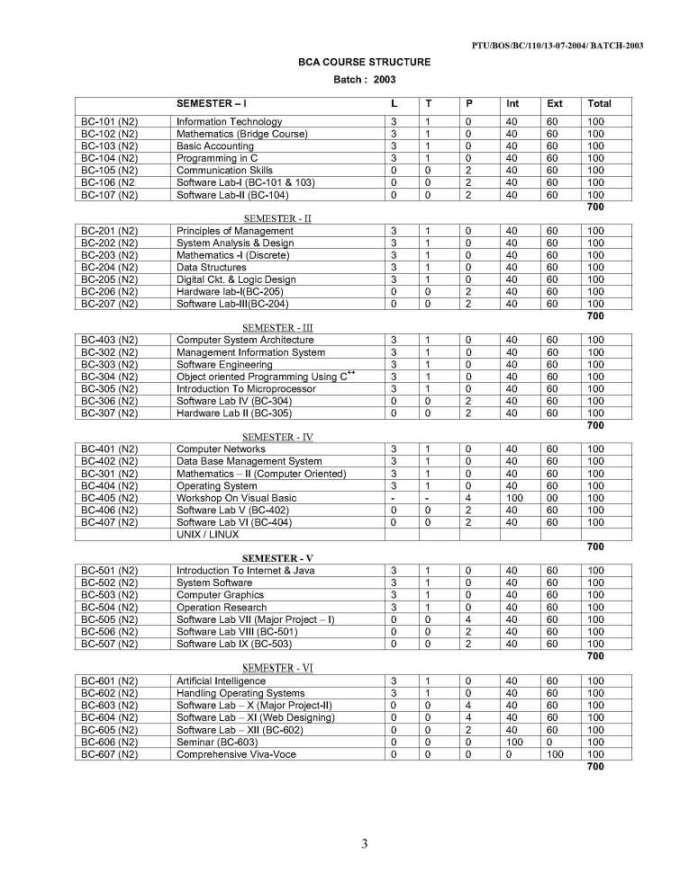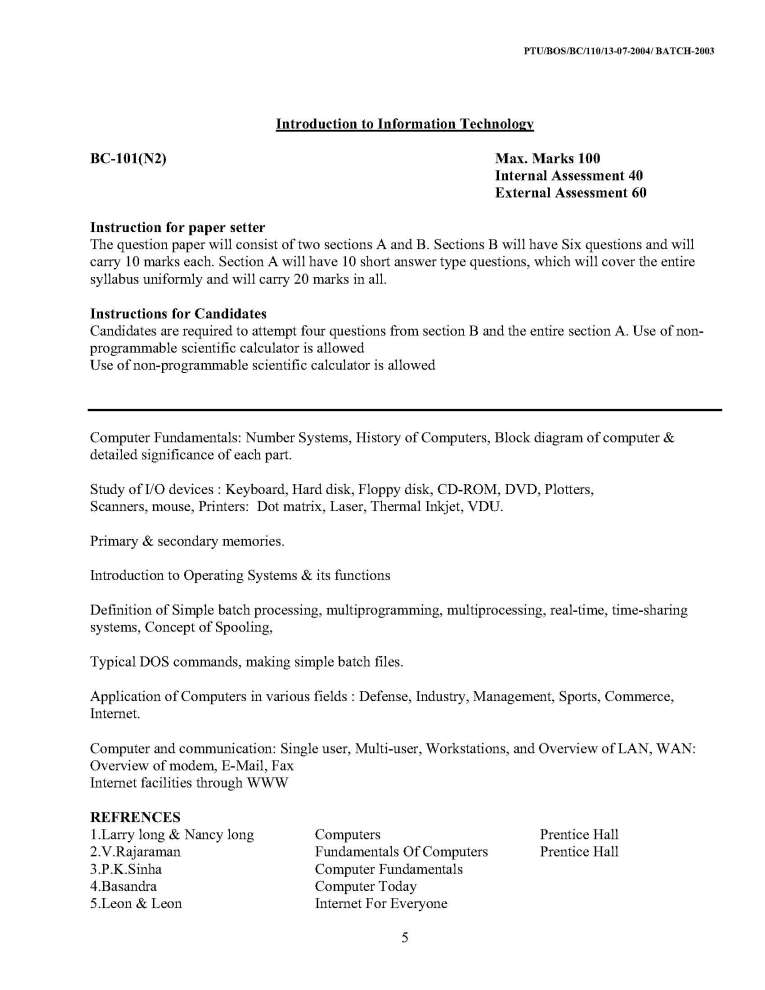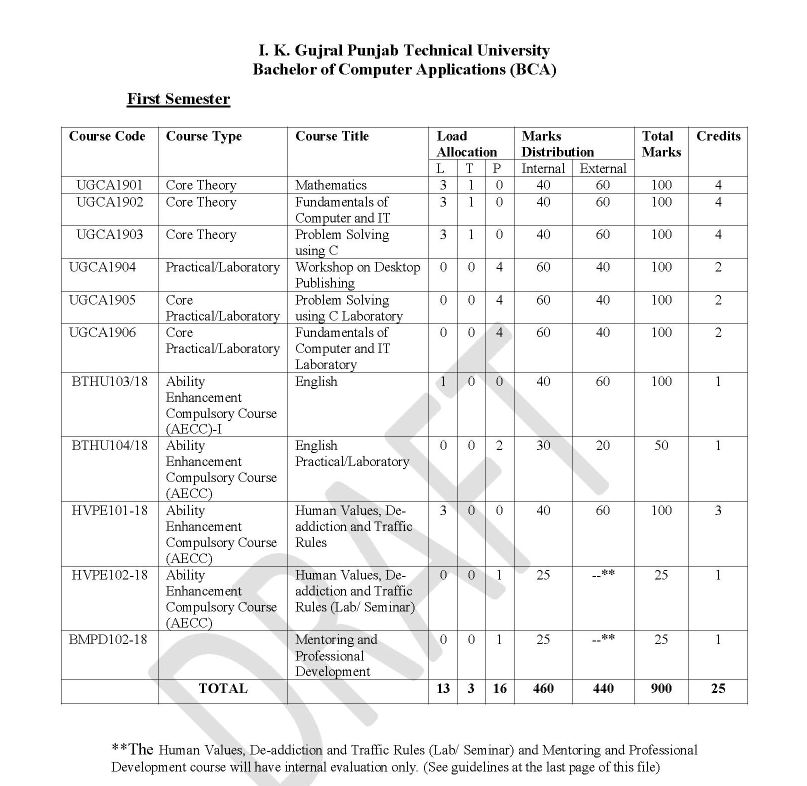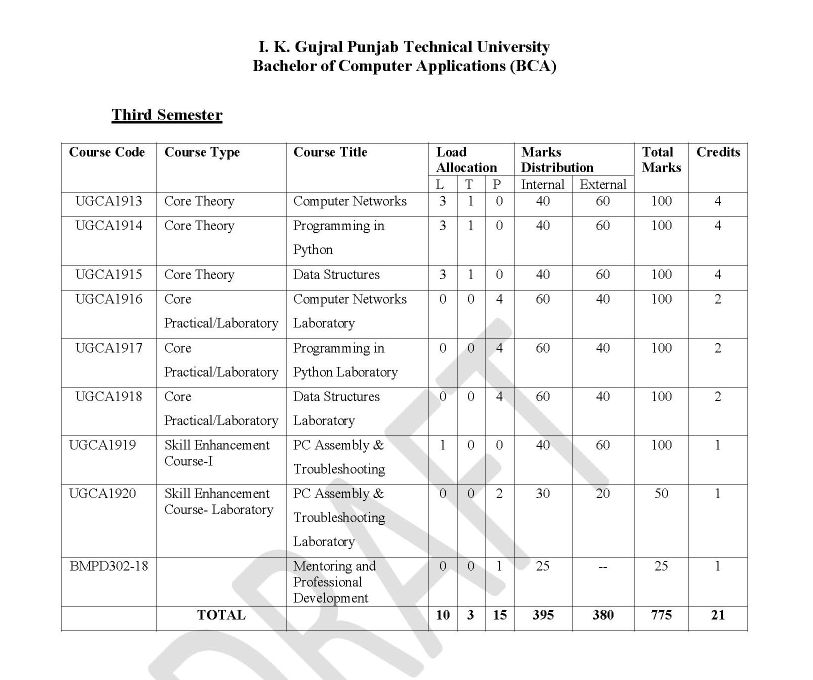| Re: PTU BCA 3rd SEM syllabus
As you want I am here providing you syllabus of the 3rd semester of BCA program of Punjab Technical University, Jallandhar.
3rd semester of BCA program syllabus:
BSBC301 SYSTEM ANALYSIS & DESIGN
Objective/s & Expected Outcome: To teach the analysis and practicality of vvarious
systems on which software system can be developed. After completing this course
students will be able to design and develop systems.
SECTION-A
System Development Life Cycle: System Definition, characteristics, elements & types of
system, Phases of SDLC, Information gathering tools, Structured Analysis tools, Role of
System Analyst.
SECTION-B
System Design: Process and stages of systems design, Input / Output and file design,
Documentation (User Manual, Design Documentation, Training Manual), Case Study
techniques in system design.
SECTION-C
System testing: Unit Testing, System Testing, Integration Testing, Alpha & Beta Testing,
Acceptance Testing, Regression Testing.
SECTION-D
System Implementation: System implementation Process, Implementation methods,
System maintenance, Post implementation maintenance.
BSBC302 DATA STRUCTURES
Objective/s Expected Outcome: Objective is to make the students understand how
data is managed internally within any computer with the understanding of basic
knowledge of C and C++. The students will gain the knowledge of basics of internal
data structure.
SECTION-A
Introduction to Data Structures: Basic concept of data, Problem analysis, algorithm
complexity, Big O notation and time space trade off, Types of data structures: arrays
records, pointers, stack, queue, trees, linked list packet, blocks, tracks, sector(in storage
deices).
Searching and Sorting: Use of vvarious data structures for searching and sorting, linear
and binary search, bubble sort, insertion sort, selection sort.
SECTION-B
Stacks & Queues: Basics of stacks and queues, Recursion, Polish notation, circular
Queues, priority Queues.
SECTION-C
Linked Lists: Single linked list, Circular linked list, Doubly linked list and Dynamic
storage management, generalized list, Garbage Collection.
SECTION-D
Trees: Definition & Concepts, Basic trees, Binary tree representations, Binary tree
traversals and application of trees.
BSBC303 DIGITAL CIRCUITS & LOGIC DESIGN
Objective/s & Expected Outcome: To give knowledge about the vvarious electronics components and
digital circuits to the students and designing of vvarious building blocks of computer system. After
studying this subject students will be able to design small projects and can easily understand the
internal working of digital electronic circuits
SECTION-A
Number System: Decimal Number System, Binary Number System, Octal Number System, Hexadecimal
Number System, Conversion from One Number System to another, Arithmetic Operation
without Changing the Base, 1‟s Complement and 2‟s Complement. Logic Gates: AND, OR, NOT,
NAND, NOR, XOR, XNOR, NAND & NOR as Universal Gates, Logic Gates Applications.
SECTION-B
Boolean Algebra: Introduction, Theorems, Simplification of Boolean Expression using Boolean
Algebra, SOP & POS Forms, Realization of Boolean Expression using Gates, K-Maps, Simplification of
Boolean Expression using K-Maps. Combinational Logic Circuits: Half Adder & Half Subtractor, Full
Adder & Full Subtractor, Parallel Binary Adder, Binary Adder/Subtractor.
SECTION-C
Combinational Logic Circuits: Multiplexers & Demultiplexers, Implementation of Boolean equations
using Multiplexer and Demultiplexer, Encoders & Decoders. Sequential Logic Circuits: Latch, Flip
Flops- R-S Flip-Flop, J-K Flip-Flop, Master-Slave J-K Flip-Flop, Race Condition, Remoing Race
Condition, D Flip-Flop, T Flip-Flop, Applications of Flip-Flops.
SECTION-D
Counters: Clock Pulse Generator using 555 Timer as Monostable and Multivibrator, Design of
Asynchronous Counters, Design of Synchronous Counters, Up-Down Counters, MOD-N Counters.
BSBC304 WORKSHOP ON VISUAL BASIC
Objective/s & Expected Outcome: The objective of this syllabus is to help the students in finding
solutions to various real life problems and converting the solutions into computer program using
Visual Basic (Event Driven programming).Students will be able to create software with 2 tier or 3 tier
architecture. Students will learn about event driven programming and database access.
SECTION-A
Introduction to Visual Basic :The Visual Basic Program Development Process; The Visual Basic
Environment; Opening a Visual Basic Project; Saving a Visual Basic Project; Running a Visual
Basic Project. Visual Basic Fundamentals: Constants; variables; Data Types and Data
Declarations; Operators and Expressions; String Expressions; Library functions , Branching and
Looping Statements, Relational Operators and Logical Expressions; Branching with the if-Then
Block; Branching with if-Then -Else Blocks; Selection: Select-case; Looping with for-Next; Looping
With Do-Loop; Looping with While-Wend Visual Basic Control Fundamentals: Visual Basic
Control Tools; Control tool Categories; Working with controls; Naming Forms and Controls;
Assigning Property aloes to Forms and Controls; Executing Commands(Event Procedures and
Command Buttons). Display Output Data (Labels and Text Boxes);Entering Input data(Text Boxes);
selecting Multiple Features(Check Boxes); selecting Exclusion Alternatives(Option Button and
Frames). Assigning Properties Collectively (The With Block); Generating Error Messages (The
MsgBox Function); Creating Times Events; Scrollbars
SECTION-B
Menus and Dialog Boxes :Building Drop-down Menus; accessing a Menu from the Keyboard;
Menu Enhancements; Submenus; Pop-up Menus; Dialog Boxes; Input Box. Executing and
Debugging a New Project : Syntax Errors; Logical Errors; Setting break Points; Defining Watch
values; Stepping Through a Program; User- Induced Errors; Error Handlers. Procedures: Modules
and Procedures; Sub Procedure; Event Procedures; Function. Arrays: Array Characteristics; Array
declarations; Processing Array Elements; Passing Arrays to Procedures; Dynamic Arrays; Array-
Related Functions; Control Arrays
SECTION-C
Using Class Modules: Object Oriented Principles; Creating Class Modules; Using Class Modules
Adding Properties and Events and Methods. Using COM Components : Introduction to ActiveX
Components and Component Object Model; Benefits of COM; Clients and Serers; Types of
ActiveX Components Available in Visual Basic; Creating user defines ActiveX Components;
Managing Components; The Visual Component Manager; Registering and Un Registering
Components. ActiveX Controls : Creating an ActiveX Control; Benefits of ActiveX Control; Adding
Properties; Methods and Events to the Control; Managing and Distribution of the Control; Built-in
Active X Controls. ActiveX EXE and ActiveX DLL: Introduction to ActiveX DLL and EXE; Creating
ActiveX EXE Component; Creating ActiveX DLL Component
SECTION-D
Data Access using ADO : Data Access Technology with B ; The ActiveX Data Object Model;
Advantages of ADO and OLEDB; Connecting to a Data Source; Retrieving from a Data Source;
Sorting and Searching Data; Updating Data; Creating Dynamic Record Sets; Using Cursors; Cursor
Types; Locking; Accessing ADO Data Control. Data Environment and Data Report: Introduction;
Data Environment Designers; Working with Data Reports; Cut different types of Data Reports.
BSBC305 BASIC ACCOUNTING
Objective/s & Expected Outcome: This course provides an orientation in the field of accounting
and basic accounting fundamentals. After completion of this course, candidate would be able to
record and post transactions in the basic accounting equation and maintain subsidiary ledgers.
SECTION-A
Basic Accounting Concepts: Background of Accounting, Introduction, importance and scope,
Accounts – Types and classification; basic terms– Capital, Income, Expenditure, Expenses,
Assets, Liabilities and application to Problems., Accounting Equation, Double Entry System.
Generally accepted accounting principles.
SECTION-B
Journal and Ledger- Journal and recording of entries in journal with narration; Ledger –Posting
from Journal to respective ledger accounts. Basic concepts of purchase book, sales book and
cashbook. Trial Balance: Need and objectives; Application of Trial Balance; different types of
errors escaped, trial Balance preparation.
SECTION-C
Final Accounts: Final Accounts without adjustments. Bank Reconciliation Statement: Bank
transactions, Preparation of simple bank reconciliation statement.
SECTION-D
Sources of raising of capital in corporate undertaking: working Capital and Long term Capital.
Application of computers in accounting.
BSBC306 SOFTWARE LAB-I (Data Structures)
Note: Program should be fully documented with sample I/O. Data Flow charts should be developed
wherever necessary.
Write an Algorithm and Program using functions for:
1. Program using Recursion.
2. Traversing the elements of an Array
3. Inserting an element in an Array
4. Deleting an element from an Array
5. Merging of two Arrays
6. Linear Search
7. Binary Search
8. Insertion Sort
9. Bubble Sort
10. Selection Sort
11. Implementing PUSH & POP operations of a Stack
12. Array Implementation of a Queue and Circular Queue
13. Converting infix notation into post fix notation
14. Insertion in single and double Linked List
15. Deletion from single and double Linked List
BSBC307 HARDWARE LAB-I (Digital Circuits & Logic Design)
Basic Electronics: Introduction to Diode, Diode as Logic Element, Schottky diode, Transistor, Transistor
Characteristics, Transistor as a Switch & Logical Element, Introduction to TTL and MOS Technology,
Transformer.
Practicals:
1. To study the function of basic logic gates and erify the truth table of AND, OR, NOT, X OR, NAND, NOR.
2. To study applications of AND, OR, NAND, X-OR gates for gating digital signals.
3. To develop the different Arithmetic Circuits:
a. Half-Adder and Subtractor.
b. Full-Adder and Subtractor.
4. To study the BCD to binary and binary to BCD Code converter.
5. Study of Decoder Circuits:
a. BCD-to-Decimal Decoder
b. BCD-to-7-Segment Decoder
6. Study of Encoder Circuits:
a. BCD-to-Decimal Encoder
b. Octal-to-Binary Encoder
7. To study the flip flop circuit using Gates:
a. R-S Flip Flop
b. J-K Flip Flop
c. Master Slave J-K Flip Flop
d. D-Flip Flop
8. To study R-S, J-K and D Flip Flop Using IC’s.
9. Study of Ring Counter.
10. Study of Asynchronous and Synchronous Counters.
|







